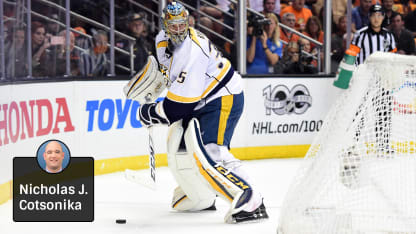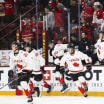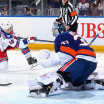Rinne said he has never been told to stay in the net.
"I remember sometimes when I've made a mistake, and it looks bad when you're behind the net or something like that," Rinne said. "But I feel like if you do it the right way, it's a big advantage."
Once Rinne controls the puck, he doesn't necessarily move it immediately. That backs off the forecheckers because they don't know what he's going to do and have to respect him. He plays the puck to his safety-valve defenseman, rims it around the boards or clears it himself. Often the Predators are skating back up ice with speed. Usually the worst that happens is a regroup.
"For me, it's awesome to have that," Ekholm said. "You always have to skate hard back, but you know if he knocks it down, they aren't going to come as hard because they know he can play the puck well. If we can break down their forecheck, that's really good for us because we can get the offensive game going."
None of this is a secret. Predators coach Peter Laviolette said he has used essentially the same system in the NHL for a decade. Rinne has been playing pucks in the NHL for about as long. But the Predators have the right mix of personnel, and they're clicking. Opponents try to carry the puck through the neutral zone, try to avoid dumping it in, try to chip it across the zone into the corners where Rinne can't play it, try whatever they can. Easier said than done.
The Chicago Blackhawks struggled so badly against Nashville in the Western Conference First Round that they scored three goals in the series and got swept, despite having great players like center Jonathan Toews, right wing Patrick Kane and defenseman Duncan Keith. Coach Joel Quenneville called the Predators' system "Red Rover," after the playground game where kids link arms, call over an opponent and the opponent tries to break through the chain.


















